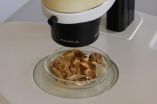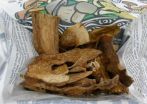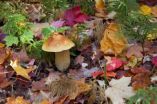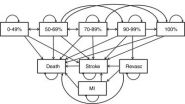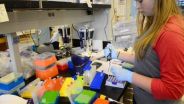(Press-News.org) For lovers of wild foods, autumn harks a season of bounty. Fungi of dizzying variety erupt from wood and soil, luring intrepid collectors to woodlands in search of elusive but delectable wild mushrooms. Part of their appeal lies in the allure of the treasure hunt, and their mysterious not-quite-meat, not-quite-vegetable qualities that belie an almost otherworldly existence. But are the mushrooms which you are eating known to science?
The Fungi Kingdom is enormously diverse yet vastly underdocumented – although some estimates range up to 10 million species, only about 100,000 species have been described. Mushrooms are one the most conspicuous and well known groups of Fungi and make up around 16,000 named species, but only a handful of these species are well documented. With estimated rates of Fungi extinction exceeding current rates of description, the enormity and urgency of the task of accurate identification cannot be overstated. New approaches that accelerate the documentation and description of new species are desperately needed before it is too late.
So how well do we really know the mushrooms? In an article published today in PeerJ, Mycologists Bryn Dentinger and Laura Martinez-Suz from the Royal Botanic Gardens, Kew in London set out to ask this question by using DNA-based taxonomy. But instead of venturing into the wild in search of never before seen species, they simply went to a local grocer and bought a packet of dried porcini whose intended destiny was more likely a rich risotto than a DNA sequencer.
Some of the most sought-after of wild mushrooms are the sweet and nutty Boletus edulis and allies, often referred to by the Italian common name porcini. Dentinger has been studying porcini for over 10 years and knew that if the porcini in this packet originated in China, they were likely to be made up of unnamed species. But how many species could be detected in the packet and how quickly could diagnosing and describing them be accomplished?
Drs Dentinger and Suz arbitrarily selected 15 pieces of mushroom from the packet and sequenced the fungal DNA barcode region for each. They then compared these sequences to sequences in the International Nucleotide Sequence Database and classified them based on evolutionary relationships. This revealed three distinct species, none of which were known to science, or had scientific names. To expedite the formal naming process required by the International Code of Nomenclature for algae, fungi and plants, the researchers used a rapid e-publishing tool that facilitates immediate name registration and species diagnosis to satisfy the rules of the Code.
"This study demonstrates that the whole procedure, from unknown mushrooms to names, can be done rapidly – we did this in under a week, but if push came to shove, it could be done in a day" said Dr Dentinger.
Hundreds of thousands of tons of porcini are collected from the wild and sold around the world every year, most of it ending up in Europe and North America. Although typically composed of five well-known species native to these regions (B. aereus, B. edulis, B. pinophilus, B. reticulatus, B. rex-veris), around half of all porcini traded in Europe originates in China. These porcini, typically collected from the wild in Yunnan province, have been exported to Europe since the 1970s yet until last December, none of them had scientific names. The researchers named them with Chinese epithets referring to local common names for porcini (Boletus meiweiniuganjun, Boletus bainiugan) and the Chinese word for 'edible' (Boletus shiyong).
As Dr Dentinger put it, "our results demonstrate just how ubiquitous unknown fungal diversity is – it can literally be found right under our noses."
The researchers hope that by demonstrating the rapid identification and naming of new Fungi species in this way, others in the community will be inspired to continue the important work of identifying new Fungi species before they disappear.
INFORMATION:
Link to the Published Version of the article (quote this link in your story – the link will ONLY work after the embargo lifts): https://peerj.com/articles/570 - your readers will be able to freely access this article at this URL.
Citation to the article: Dentinger and Suz (2014), What's for dinner? Undescribed species of porcini in a commercial packet. PeerJ 2:e570; DOI 10.7717/peerj.570
About PeerJ
PeerJ is an Open Access publisher of peer reviewed articles, which offers researchers a lifetime publication plan, for a single low price, providing them with the ability to openly publish all future articles for free. PeerJ is based in San Francisco, CA and London, UK and can be accessed at https://peerj.com/. PeerJ's mission is to help the world efficiently publish its knowledge.
All works published in PeerJ are Open Access and published using a Creative Commons license (CC-BY 4.0). Everything is immediately available—to read, download, redistribute, include in databases and otherwise use—without cost to anyone, anywhere, subject only to the condition that the original authors and source are properly attributed.
PeerJ has an Editorial Board of almost 900 respected academics, including 5 Nobel Laureates. PeerJ was the recipient of the 2013 ALPSP Award for Publishing Innovation.
PeerJ Media Resources (including logos) can be found at: https://peerj.com/about/press/
Media Contacts
Note: If you would like to join the PeerJ Press Release list, visit: http://bit.ly/PressList
For the authors: Bronwyn Friedlander: Senior PR Manager, +44 (0)20 8332 5605, b.friedlander@kew.org
For PeerJ: email: press@peerj.com , https://peerj.com/about/press/
Abstract (from the article):
Accurate diagnosis of the components of our food and a standard lexicon for clear communication is essential for regulating global food trade and identifying food frauds. Reliable identification of wild collected foods can be particularly difficult, especially when they originate in under-documented regions or belong to poorly known groups such as Fungi. Porcini, one of the most widely traded wild edible mushrooms in the world, are large and conspicuous and they are used as a food both on their own and in processed food products. China is a major exporter of porcini, most of it ending up in Europe. We used DNA-sequencing to identify three species of mushroom contained within a commercial packet of dried Chinese porcini purchased in London. Surprisingly, all three have never been formally described by science and required new scientific names. This demonstrates the ubiquity of unknown fungal diversity even in widely traded commercial food products from one of the most charismatic and least overlooked groups of mushrooms. Our rapid analysis and description makes it possible to reliably identify these species, allowing their harvest to be monitored and their presence tracked in the food chain.
What's for dinner? Rapidly identifying undescribed species in a commercial fungi packet
2014-09-16
ELSE PRESS RELEASES FROM THIS DATE:
Imaging identifies asymptomatic people at risk for stroke
2014-09-16
OAK BROOK, Ill. – Imaging can be a cost-effective way to identify people at risk for stroke who might benefit from aggressive intervention, according to a new modeling study published online in the journal Radiology.
The study looked at people with asymptomatic carotid artery stenosis, a narrowing of the major blood vessels supplying blood to the head due to atherosclerosis, or plaque buildup. Carotid artery stenosis is the primary cause of up to 20 percent of ischemic strokes, which result from an obstruction within a blood vessel and make up 85 percent of all strokes. ...
Researchers debunk myth about Parkinson's disease
2014-09-16
Using advanced computer models, neuroscience researchers at the University of Copenhagen have gained new knowledge about the complex processes that cause Parkinson's disease. The findings have recently been published in the prestigious Journal of Neuroscience.
The defining symptoms of Parkinson's disease are slow movements, muscular stiffness and shaking. There is currently no cure for the condition, so it is essential to conduct innovative research with the potential to shed some light on this terrible disruption to the central nervous system. Using advanced computer ...
Dental and nutrition experts call for radical rethink on free sugars intake
2014-09-16
Sugars in the diet should make up no more than 3% of total energy intake to reduce the significant financial and social burdens of tooth decay, finds new research from UCL (University College London) and the London School of Hygiene & Tropical Medicine.
The study, published in the open-access journal BMC Public Health, analysed the effect of sugars on dental caries, also known as tooth decay. They show that sugars are the only cause of tooth decay in children and adults.
Free sugars are defined by the World Health Organisation Nutrition Guidance Adivisory Group as follows: ...
Collaboration drives achievement in protein structure research
2014-09-15
When this week's print issue of the journal Science comes out, a collective cheer will go up from New Mexico, Montana and even the Netherlands, thanks to the type of collaborative effort that is more and more the norm in these connected times. Yes, the research was brilliant, and if we're lucky, it will produce innovations in biology, medicine, biotechnology and agriculture. It could save lives, and it happened because this scientist talked with that one, that one knew another one, and brilliant minds overcame geographic distance to advance human understanding.
"It is ...
Certain form of baldness at age 45 linked to higher risk of aggressive prostate cancer
2014-09-15
A new, large cohort analysis from the prospective Prostate, Lung, Colorectal and Ovarian (PLCO) Cancer Screening Trial, indicates that men who had moderate baldness affecting both the front and the crown of their head at age 45 were at a 40% increased risk of developing aggressive prostate cancer (usually indicates a faster growing tumor resulting in poorer prognosis relative to non-aggressive prostate cancer) later in life, compared to men with no baldness. There was no significant link between other patterns of baldness and prostate cancer risk. The study, published September ...
Researcher develops and proves effectiveness of new drug for spinal muscular atrophy
2014-09-15
COLUMBIA, Mo. – According to recent studies, approximately one out of every 40 individuals in the United States is a carrier of the gene responsible for spinal muscular atrophy (SMA), a neurodegenerative disease that causes muscles to weaken over time. Now, researchers at the University of Missouri have made a recent breakthrough with the development of a new compound found to be highly effective in animal models of the disease. In April, a patent was filed for the compound for use in SMA.
"The strategy our lab is using to fight SMA is to 'repress the repressor,'" said ...
EEG study findings reveal how fear is processed in the brain
2014-09-15
DALLAS, TX – September 12, 2014 - An estimated 8% of Americans will suffer from post traumatic stress disorder (PTSD) at some point during their lifetime. Brought on by an overwhelming or stressful event or events, PTSD is the result of altered chemistry and physiology of the brain. Understanding how threat is processed in a normal brain versus one altered by PTSD is essential to developing effective interventions.
New research from the Center for BrainHealth at The University of Texas at Dallas published online today in Brain and Cognition illustrates how fear arises ...
Smithsonian scientists discover tropical tree microbiome in Panama
2014-09-15
Human skin and gut microbes influence processes from digestion to disease resistance. Despite the fact that tropical forests are the most biodiverse terrestrial ecosystems on the planet, more is known about belly-button bacteria than bacteria on trees in the tropics. Smithsonian scientists and colleagues working on Panama's Barro Colorado Island discovered that small leaf samples from a single tree were home to more than 400 different kinds of bacteria. The combined sample from 57 tree species contained more than 7,000 different kinds.
Bacteria in tropical forests may ...
Scientists discover RNA modifications in some unexpected places
2014-09-15
CAMBRIDGE, Mass. (September 15, 2014) – The so-called central dogma of molecular biology—that DNA makes RNA which makes protein—has long provided a simplified explanation for how genetic information is deciphered and translated in living organisms.
In reality, of course, the process is vastly more complicated than the schema first articulated nearly 60 years ago by Nobel Laureate Francis Crick, co-discoverer of the DNA's double-helix structure. For one, there are multiple types of RNA, three of which—messenger RNA (mRNA), transfer RNA (tRNA), and ribosomal RNA (rRNA)—are ...
Study first to use brain scans to forecast early reading difficulties
2014-09-15
UC San Francisco researchers have used brain scans to predict how young children learn to read, giving clinicians a possible tool to spot children with dyslexia and other reading difficulties before they experience reading challenges.
In the United States, children usually learn to read for the first time in kindergarten and become proficient readers by third grade, according to the authors. In the study, researchers examined brain scans of 38 kindergarteners as they were learning to read formally at school and tracked their white matter development until third grade. ...
